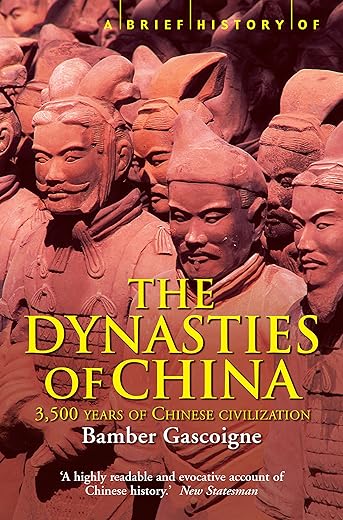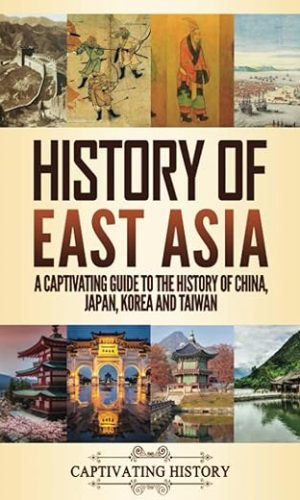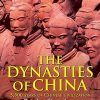A Brief History of the Dynasties of China (Brief History) (Brief Histories)
£5.10£9.50 (-46%)
Although China’s great empire lasted for longer than any other, no country has suffered so great an imbalance between the fame of its art and obscurity of its history. The names of the great dynasties are familiar, yet who can actually locate a T’ang horse or a Ming vase in its social or cultural context?
By focusing on the key colourful characters of the eight major dynasties, Bamber Gascoigne brings to life 3500 years of Chinese civilization. His bird’s-eye view starts on the borders of myth. It moves swiftly on to the greatest achievements of language and thought, the cultural treasures and imperial palaces, wars won and lands lost to the Mongols, finally to arrive at the 1912 Revolution, which contained within it the seeds of Communism that ensured the overthrow of the last emperor. Via this portrait of an empire and its peoples he has opened the door to a world for too long inaccessible to the West.
Read more
Additional information
| Publisher | Robinson, UK ed. edition (25 Sept. 2003) |
|---|---|
| Language | English |
| Paperback | 240 pages |
| ISBN-10 | 1841197912 |
| ISBN-13 | 978-1841197913 |
| Dimensions | 13 x 2 x 19.4 cm |




by George Norris
Bamber compresses several millennia into a weekends reading, a brilliant introduction whose brevity makes the whole story hang together memorable. I decided to try and go one further and get all of China’s history into a couple handful of tweets, one per dynasty:
Shang’: human sacrifice, mystics, amazing bronzes.
Zhou’: literature, Confucius and Daoism.
Qin’: violence, terracotta warriors (and all the workmen) buried with the nutter. Lasted just a generation but created Qina and the wall.
Han’: peasant Gaozu, whose jealous wife Empress Lu amputated Lady Qi and left her to die in a latrine, so said castrated historian Sima Qian. Cemented China until 3 kingdoms in-fighting.’
Tang’: dark ages with awesome pottery,poetry,portraits, Bhuddism & building the grand canal. AnShi rebellion killed 36 million (15% of world pop, only WWII killed more).
Song’: Scholar officials,and artist-emporer Huizong. Intellectually strong and militarily weak (but built navy) ”. The Water Margin’ set in this time.
Yuan’. The Mongol Kublai Khan (Jengis’ grandson) made easy meat of the arty farty Song. Beijing became capital (closer to Mongolia than Xian). Invaded Japan (2ce)150,000 men,4,500 ship armada. Zhu Qing & Zhuang xuan (grain merchants) executed for profiteering’ capitalism gets a bad name.
Ming’: Built forbidden city (labour of >1million of china’s 60million)’Despotic (Zhu Di had his favourite concubines buried alive in his tomb), heirachical. Jesuit Ricci arrives (with clock). Eunuch admiral Zheng He’s (grandpise and costly) Treasure Fleet reached Persia (some say America) then Mings banned shipping and turned inward. Qings fought the Mings and 25 million deaths later…
Qing’: 2nd foreign dynasty: this one less so (Manchurian). Foreigners arrive guns ablaze. Brits twice trashed Beijing to sell drugs. Taiping rebellion (a christian nut) killed 20 million. CiXi built a palace instead of navy. China declined to its weakest point in recorded history, no wonder the 1912 Revolution kicked them out.
by S. Crispin
I am not a great one for history books, but wanted to brush up on my Chinese history. This was a very readable and easy to digest book. I can imagine the first draft ran to a much heftier tome. Those that want the details will have to look elsewhere but a great place to start and as it says on the cover, ‘a brief history.’
by Mike Sadler
I read this to give me a quick overview of China before going there. It’s half an inch thick, and covers the basic dynasties in a very engaging and easy to read manner. Even 15 years later I can more or less remember the order of the dynasties – which impressed my Chinese colleague!
by Hywel James
Bamber Gascoigne’s book is an excellent short introduction to China’s long history. As he says in his introduction, in the West we are possibly more familiar with the art of China than we are about the times in which this art was produced. We know even less about the people who produced the art and for whom it was made. This account provides a clear historical time line but it doesn’t fall back on mere lists of names and dates. Far from it, instead many colourful anecdotes about people and events are attached to successive dynasties so that each one remains memorable. By this means the book offers a vivid yet concise account of three thousand years of frequently violent and tragic history up to more or less the present day. Highly recommended as an introduction to a complex subject.
by Amazon Customer
This secondhand book was in a good condition.
Whoever is interested in a brief history of chinese dynasties should have a look at this book.
by Frantisek Zak
Good introduction by a non-specialist. Reads like a breeze.
by Guillermo Roa
China’s history was a mistery for me. I knew just a few names and a few facts, and I wanted a readable book to build my own basic scheme about it. This book is really usefull to do so. Taking into account that such a big history has to be simplified to include it in such a little book, I started reading with great interest. It’s not of course China’s history as a whole. It’s just the biggest dynasties’ history. In fact, that is perfect to have a general sight over China’s timeline. My language is not engish, and anyway, I’ve found this book easy to read.
by A. Nim
A Brief History of the Dynasties of China is a fantastic introduction to understand the culture and history of China from the beginning till the end of the monarchy in China, roughly 1912.
Gascoigne gives brief chapters based around each Dynasty about the situation of China at that period and what made that specific Dynasty different from the rest.
Not only do you learn about the Dynasties but also the history and understanding of Chinese culture and philosophy (Buddhism, Confucianism, Daoism, etc) .
Like I mentioned above, this is just a brief ‘introduction ‘, there are definitely books out there that provide more detail about Chinese history.
You get exactly what the title of the book refers to.
I recommend this to anyone who is interested in Chinese History or culture/philosophy in general.
It’s quite short and you should be able to finish it from about 4-7 days.